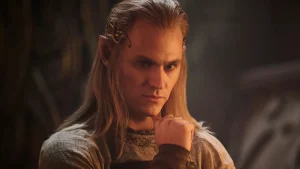The 90s were the last great era of cel animation. You got directors like Satoshi Kon and Mamoru Oshii pushing psychological and cyberpunk stories (Perfect Blue, Ghost in the Shell), while TV took risks with structure and tone (Neon Genesis Evangelion wasn’t afraid to get messy).
What made the 90s different was range paired with intent. In one decade you had prestige films (Princess Mononoke setting records in 1997), stylish genre blends (Cowboy Bebop mixing noir, jazz, and space western), and offbeat experiments that stuck (Serial Experiments Lain turning early internet dread into mood). Today’s anime is bigger and sleeker, but the 90s feel distinct because the medium treated each project like a test lab. Even the cult titles people forget still carry that mix of ambition and handmade grit.
Jungle Emperor Leo (1997) is an animated remake of Osamu Tezuka’s classic Kimba the White Lion. The story follows Leo, a noble white lion who rules over the jungle with wisdom. But life isn’t all sunshine and roaring. Humans from the outside world are trying to exploit the jungle for resources, and Leo is caught in an impossible struggle to protect the wild itself. If you loved movies like The Lion King (and yes, there’s a whole debate about whether Disney borrowed ideas from Kimba), or if you’re into stories like Princess Mononoke, this is definitely worth your time.
Ninku is that quintessential 90s martial arts anime that flew under the radar for most Western audiences but definitely deserves more recognition. It follows Fuusuke, the last survivor of the Ninku corps. The Ninku were feared during a massive war, but after the conflict ended, they were branded as villains and scattered. Now, Fuusuke is on a journey to reunite with his old comrades and clear their name, all while fighting off bounty hunters, mercenaries, and remnants of the forces that betrayed them. Oh, and he brings along his pet penguin, Hiroyuki, because why not? (Yes, there’s a penguin sidekick. It’s as random as it sounds.)
Silent Möbius is a slice of 90s cyberpunk anime goodness. Set in a futuristic Tokyo, the story follows the AMP (Attacked Mystification Police), an all-female task force that battles otherworldly creatures called Lucifer Hawks. Silent Möbius nails that aesthetic of towering megastructures, glitchy technology, and the spiritual colliding with the technological. The series is remarkably female-centric for its era with complex women characters who aren’t just there for fanservice. It’s not as well-known as other cyberpunk anime like Akira or Ghost in the Shell, but it’s just as ambitious in its storytelling.
Nadia: The Secret of Blue Water is loosely inspired by 20,000 Leagues Under the Sea by Jules Verne but goes off in its own imaginative direction. Set in the late 19th century, it follows Nadia, a mysterious girl with a magical pendant (the Blue Water) and Jean, a young inventor. They get swept up in a globe-trotting adventure with Captain Nemo, his submarine the Nautilus, and an ancient Atlantean civilization.
Captain Nemo is one of anime’s great complex father figures, and the crew of the Nautilus provides that found-family dynamic that just hits right in the feels. The animation still holds up remarkably well, with action sequences that demonstrate why Anno became such a big deal and creature designs that showcase the Miyazaki influence — he was involved in early concept work before the project went to Gainax.
El-Hazard: The Magnificent World is peak 90s isekai before “isekai” was even a term everyone threw around. The story follows high school student Makoto Mizuhara who, along with his crush Nanami, his teacher Mr. Fujisawa, and his arch-nemesis Jinnai, gets transported to the fantasy world of El-Hazard. The twist? Everyone gets special powers in this new world except poor Jinnai, who just gets the ability to communicate with giant bugs (which, to be fair, he leverages spectacularly as he becomes their evil general). Oh, and Makoto has to impersonate a missing princess because he looks exactly like her, leading to all sorts of hijinks and misunderstandings.
Princess Nine is a late-90s sports drama about an all-girls high school baseball team trying to crash Japan’s boys’ Koshien tournament. It’s about breaking boundaries, chasing dreams, and proving that girls can kick just as much butts on the field as the boys. It’s definitely worth a watch, especially if you’re into underdog stories with relatable characters and a lot of emotional depth. It’s only 26 episodes, making it a manageable watch compared to some sports anime behemoths.
For myth-flavored bio-horror and a tsundere demi-demon bodyguard trying not to care (and failing), Blue Seed is a fun time capsule. The story follows Momiji Fujimiya, a normal high school girl who discovers she’s the “Kushinada”— a human sacrifice meant to appease these plant-monster things called Aragami that are trying to reclaim Japan from humanity. Instead of accepting her destiny as monster chow, she teams up with the Terrestrial Administration Center (TAC) to fight these creatures. Her protector is Mamoru Kusanagi, a half-Aragami boy who initially wanted to kill her but develops feelings for her instead. Classic 90s romance. Momiji eventually discovers she has powers of her own through a “blue seed” (a magical plant bead) embedded in her chest.
The Big O is a neo-noir mecha mystery set in Paradigm City, a place where everyone lost their memories 40 years ago and just… kept living. It follows Roger Smith, a “negotiator” who solves problems for the city’s elite while moonlighting as the pilot of a massive black mecha called Big O. Assisted by his android companion Dorothy and his butler Norman, Roger navigates a city where memories are the most valuable currency and giant robot battles are somehow both rare and commonplace.
Each case he takes on peels back another layer of the amnesia mystery while introducing new mechs (called Megadeuses) and the disturbing truth behind Paradigm City’s existence. The series was supposed to be longer but got cut short, leaving viewers with more questions than answers. Season 2 (co-funded by Cartoon Network back in the day) answers some questions while raising others, and the finale is famously polarizing.
Puppet Master Sakon combines traditional Japanese puppetry with murder mysteries in a way that’s actually compelling. The story follows Sakon Tachibana, who’s a master puppeteer of Bunraku (traditional Japanese puppet theater). Sakon keeps stumbling into crime scenes (as one does), and his unique perspective as a puppeteer gives him insight into human psychology and the “strings” that manipulate killers. Each case reveals something about Japanese culture, art, or tradition while Sakon untangles the web of motives and clues.
Key the Metal Idol is a sci-fi drama with a heavy dose of existential dread. The story revolves around Tokiko “Key” Mima, a socially awkward girl who believes she’s a robot. Her grandfather, a scientist who recently passed away, programmed her with the belief that she can become human — but only if she can make 30,000 friends. She heads to Tokyo and decides to pursue a career as an idol, thinking this will help her reach her goal.
Things, however, take a dark turn when her journey gets tangled up people with their own selfish agendas. If you appreciate anime that treats you like an intelligent viewer and aren’t afraid of a story that will make you uncomfortable while making you think, Key the Metal Idol deserves a spot in your watchlist.
What do you think? Let us know in the comments!
The post 10 Fantastic Forgotten Anime From the 1990s appeared first on ComicBook.com.




